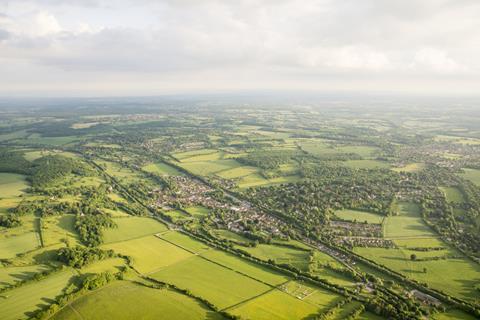Savills forecasts increases in residential land prices are expected to cool when the cost of living hits the housing market and developers face increased costs with energy efficiency demands.

Greenfield land value is forecast to grow by just 4.4% over the next five years after rising by almost 10% in the last year alone.
According to analysis from property giant Savills, the rate of growth in residential greenfield land values will slow sharply in the next few years after spiking to 9.3% between March last year and the end of the first quarter this year.
It predicts values will actually fall 3% in 2025 after three years of more modest growth.
By assessing the quarterly hypothetical valuations from its land agents across the UK, the firm estimated land value will grow 2.8% this year, 3.1% in 2023 and 1.6% in 2024.
After the drop in 2025, Savills anticipates there will be no growth in land values in the UK in 2026. In the past five years land values have increased 12.8%, Savills’ Greenfield Land Index said. The index assumes greenfield sites to be any land that has not yet been built on.
Emily Williams, Savills research analyst, said that the land value growth would slow as the housing market cooled over the next couple of years, which is likely with the rise in cost of living and potential interest rate hikes.
She also explained the amount developers could spend on land would go down because of the additional build costs they were facing in the next few years, which are mainly due to ensuring houses are more energy efficient.
She said the spike in land sale values and the strong housing market over the past 18 months was thanks to factors including chancellor Rishi Sunak’s ‘stamp duty holiday’, people rushing to meet the government’s ‘help to buy’ deadline and a lack of supply of properties compared to demand.
“We anticipate continued appetite for immediate and strategic land from the major housebuilders and SMEs, as they look to maintain steady growth in the medium term and replenish land pipelines following high levels of completions over the last 18 months,” Williams said.
But she said over the next five years the cost of building each home could go up by £10,000 or more. From June this year homes will need to be 30% more efficient, which she said the Department for Levelling Up, Housing and Communities had estimated would add around £4,000 onto the cost of building each home. Towards the end of 2023 the 10% biodiversity net gain requirement is expected to come into force, which is thought will add about £2,500 to the cost of building a home.
And in 2025 the Future Homes Standard, which will require homes to emit 75 or 80% less carbon than they do now, could mean an extra £5,000 cost on the building of each unit, Williams. Housebuilders also face the ongoing issue of a rise in material prices because of supply chain problems.
Savills have calculated that the land value growth could remain strong in the North and Midlands as affordability has not been as strong in those areas and a lot of the government’s levelling up money will be directed to those regions. In the first quarter of this year, land prices went up 1.4% in the UK as a whole, 1% in the south east, 2.3% in the West and 1.5% in the North, according to Savills.
The property firm expected the supply of consented land to remain lower than its recent peak in 2018-2019.
Patrick Eve, Savills head of regional development said: “The fact we have seen no increase in the level of consented land coming through the planning system has important consequences for our forecasts. Additional build costs and developer contributions will put downward pressure on values, but a lack of supply is likely to limit the impact of these factors.
“Developers will need to absorb new costs, and tighten margins in order to secure sites in what we expect to continue to be a competitive market.”










No comments yet